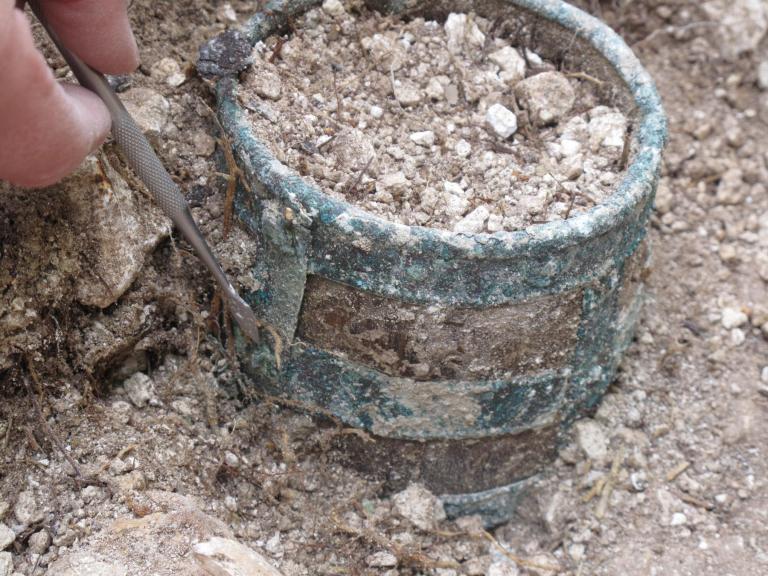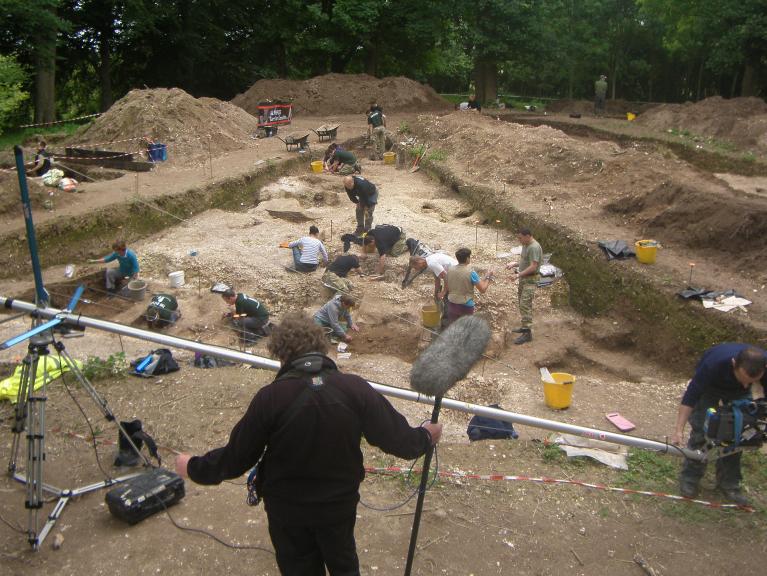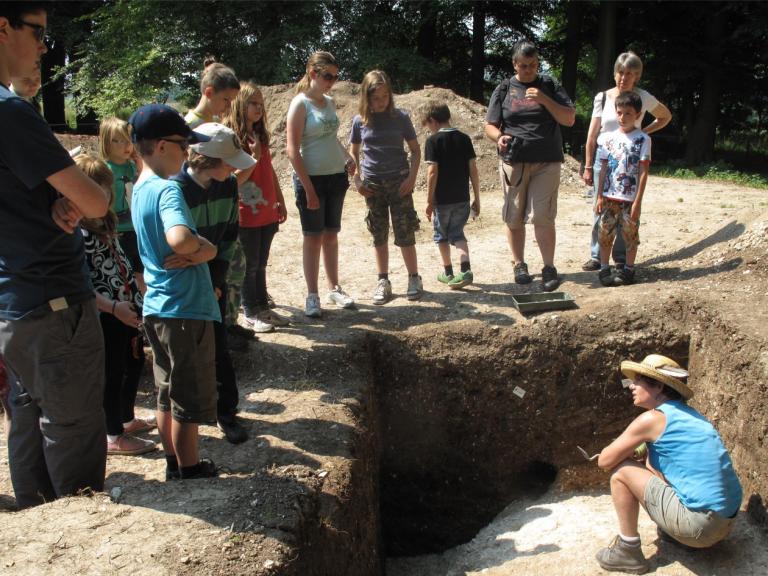51.22762196713, -1.7643463611603
Barrow Clump, on Salisbury Plain, has been a site of human activity for over five thousand years. Originally a Neolithic settlement site, a burial mound (or barrow) was constructed here in the Early Bronze Age and was re-used as a cemetery site in the Anglo-Saxon period.
Although Barrow Clump is protected by its designation as a Scheduled Ancient Monument, Operation Nightingale was given special permission to excavate and record the barrow due to the extensive damage being caused by badgers. Previous excavations were carried out on the site in the early 20th century by Lt-Colonel William Hawley and in 2003–4 by English Heritage.
The Operation Nightingale excavation took place over three summers, starting in 2012, with the aim of accurately recording this significant archaeological site as it could no longer be preserved in situ.
Finds from the Neolithic period were limited, but include sherds of pottery and worked flint. In 2013, a large Neolithic pit was identified, containing hammerstones and deer antlers, although the function of this feature is as yet unknown.
Bronze Age artefacts include an archer’s wristguard, a bone bead and a bone needle that were associated with a cremation burial. The cremated remains of two other individuals had been placed in Collared Urns. The substantial ring ditch surrounding the monument was recorded, and an earlier ‘Beaker’ phase of burial mound construction on the same site was identified. Two Beaker burials and two Bronze Age burials were found in the earlier excavations.
Evidence dating to the 6th century AD shows that the burial mound was re-used by Anglo-Saxons from a local settlement. The cemetery contained more than 70 graves of men, women and children, with limited evidence for patterns or divisions between age, gender or social class. Several of the male burials were accompanied by items associated with warfare. These include spearheads and shield bosses (the metal centres of wooden shields) as well as a sword with gilded belt fittings and remains of the wood and leather scabbard. Female burials contained items of jewellery such as brooches, rings and beads. The star find of the excavation was a rare Saxon bucket, a type of manly drinking vessel. This bronze-bound tankard is so well preserved that even the wood (yew) has survived.
Following completion of the Operation Nightingale excavations at Barrow Clump in 2014 work has focused on analysing the results, which will be published in a monograph in 2019. This will include not only the important archaeology but also a range of related studies as well as the experiences of some of the many participants in the project.
The final excavation?
When we finished at Barrow Clump in 2014 it was thought that this would be the end of fieldwork, and it was sad to leave such an exciting site. However, further badger activity on the western edge of the barrow led to a return at the end of 2017 when, in sub-zero temperatures − and in conjunction with Defence Infrastructure Organisation and Breaking Ground Heritage − we excavated a further six Anglo-Saxon inhumation graves, one with our first – and beautifully decorated – pot, while a second, plain pot contained cremated human remains – our first cremation burial at the site.
Furthermore, this work confirmed our speculation as to the extent of the cemetery to the south-west, showing it to continue approximately 30 m beyond the edge of the Early Bronze Age barrow ditch.
Barrow Clump the site that just keeps giving
We returned in July 2018, in temperatures around 40°C warmer, this time to investigate the possible damage caused to burials by wheeled military and farm vehicles on a track within 20 m of the south-west edge of the barrow. This work has shown, perhaps surprisingly, that no damage has been caused to even relatively shallowly buried individuals, but vehicle traffic has resulted in the graves being quite difficult to see, even against the white background of the natural chalk.
Of equal surprise was the number of graves and their contents. Work the previous winter had suggested that the 2018 excavation area would lie on the periphery of the cemetery − which it did − and that perhaps 15 or so mostly juvenile burials would be encountered, accompanied by relatively few grave goods – this proved not to be true! Over three very busy weeks in July a further 28 inhumation burials and five cremation burials were recorded − along with two swords, five shield bosses, eight spearheads, two saucer brooches, two small long brooches and much more, the finds seemingly all of 6th-century date, as previously. This brings the number of graves excavated to 110, with the entire cemetery likely to somewhat exceed 150 in total, placing it on a par or slightly larger than other comparable Wiltshire examples. Most of the remaining, unexcavated graves are inaccessible, lying beneath mature beech trees which may survive for another century or so.
Just over half of the graves investigated in 2018 were those of juveniles and infants, but unlike those excavated in 2012−14 most were buried with objects that included beads, buckles and knives, while two each had a small spearhead. Amongst the adult burials the two swords have, of course, attracted considerable interest, the larger with rare evidence of a baldric (a diagonal belt worn from shoulder to hip) and a little longer than the one we found in 2014 – the latter did, however, have two gilded scabbard fittings and extensive wool, wood and leather organic remains surviving. It may turn out that the second, shorter sword found in 2018 proves particularly interesting, as this may be of an unusual type. Only one adult female was present, accompanied by two gilded saucer brooches and other personal items.
The distribution of burials in this area, to the south-west of the barrow – and presumably in sight of a yet to be discovered settlement in the Avon valley below, is also of interest. The adults appear to be largely confined to the periphery of the cemetery, where burials were densest, with more infants and juveniles in a less densely populated central area. The presence of a so-called deviant burial is another first for the site, this individual unceremoniously buried within a shallow, irregular grave, on his side with arms outstretched, legs removed by later ploughing, and the body covered with nodules of flint. Is he Anglo-Saxon? – probably, but radiocarbon dating will clarify; what was the cause of death? – osteoarchaeological study may shed some further light on this unusual burial.
The results of the 2017−18 excavations, with an additional 40 Anglo-Saxon graves, come too late to be included in the publication of the earlier work, but reference will be made to them in the forthcoming monograph. Currently, the intention is to publish the further discoveries in a separate, shorter report, to follow in 2020.
To Find out more about our work with Operation Nightingale or to watch the Time Warriors video click here


